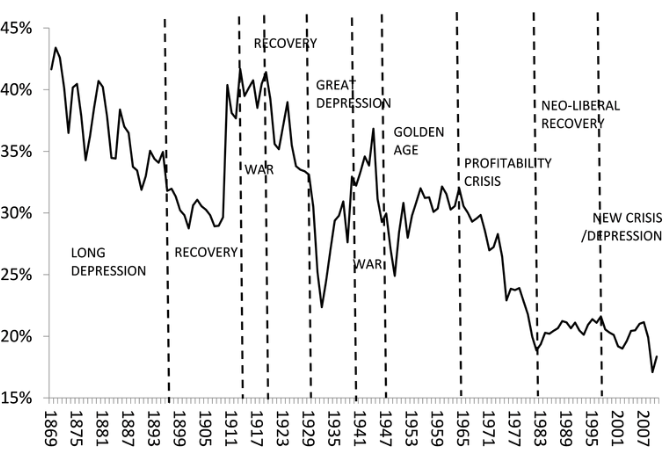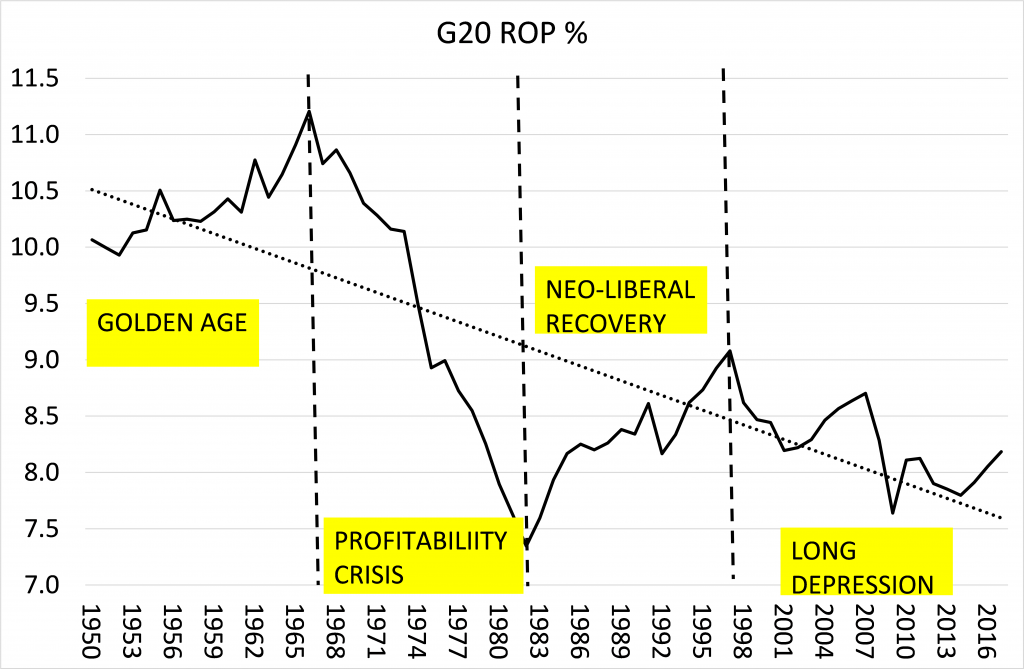- Articles
- Posted
Marx Never Hid the Falling Rate of Profit and Prolonged Stagnation Since the 1960s
All the laws of the movement and development of capitalism reflect one of the aspects of deep contradictions of this system. These are the contradictions that drive towards deadlock and moving to the new historical frame of the social production process and its purpose, i.e. to an alternative system.
However, among these laws, the law of tendency for the rate of profit to fall was the most problematic, and the least able to prove. It is one of the decisive laws, because it represents the contradiction with the basic law of capitalist production, which is (the pursuit of maximum profit). Nonetheless, with the development of statistical data at the international level, Marxist researchers started to find the tools to measure the tendency of profit at the global level, which adopts a set of measurement and approach mechanisms, given the difficulty of reaching a precise measurement of profit rate worldwide.
Nevertheless, these consecutively developed approaches of a group of the main and most affective countries, prove that the rate of profit moves upwards and downwards but within a specific direction, which is decline. So, the rate of profit in capitalist production falls throughout their stage of development, and that is with increased organic composition of capital, i.e. an increase in constant capital (C) (from materials, machines, equipment and technology) compared to variable capital (V) (human labour).
The Relationship Between the Rate of Exploitation and the Development of Technological Infrastructure
The decrease in rate of profit results when the increase in the intensity of technological developments compared to workers is bigger than the increase in the rate of exploitation, which is the added-value held by the owner’s capital in return for the values held by his workers. Therefore, this rate is related at the global level to the level of technological development, progress of science and the amount of its investment, and the level of development of positions in which capital invests its capabilities. It is also connected to the level of the resistance of societies to exploitation, political situations and the level of strife of the working that affects the rate of exploitation.
The more technology is generalized and the technical levels of the production process is raised, the more the ability of societies to face exploitation and imposing labor laws and higher levels of wages is increased. As the rate of profit is declining to reflect the turning of the surplus of the production process into developing the production base and reducing exploitation.
We present here some of the final data to measure the rate of profit at the global level, which is published in the blog of the Marxist economist Michael Roberts and include his studies and others’ studies of profit.

From the book: World in Crisis: A Global Analysis of Marx’s Law of Profitability.
The rate adopted here is for a long period of time. It is for 14 countries worldwide, and follows an approach to measure the rate based on the output. It also shows that the capitalist production that operated in the late nineteenth century at a profit rate of more than 40%, operates now at a level below 20% in 2007.
It entered the Long Depression that lasted 30 years, from 1869 until 1899. Notably, it was not able to quit this depression, and did not witness the highest stages of its recovery except through the two wars, specifically in WWI. However, it deteriorated again quickly, which reflected in the Great Depression in 1929, to rise back to approximately 23% and reach 35% at the end of the war. In addition, the long timeline shows that the system has witnessed the last stages of recovery and the increase in the rate of profit after WWII, where destruction has been fed.

70 Years of Profit Decline
With a detailed approach to the rate of profit’s tendency of the group of countries that now constitute the G20, which is the greatest in the world, the general direction of the rate of profit is quickly declining, and has gone through several stages. The first: recovery in the (Golden Age) that lasted until mid-1960s with the rate of profit reaching a peak of approximately 11%. It then started to sharply decline in the profitability crisis that prevailed in the seventies and extended till 1980 when the rate of profit fell to below 7.5%.
Afterwards, the neo-liberal period and the dominance of the global financial sector, with what is related to it from the accompanying decline of labor movement, decline in assurances and the services of workers in the core and throughout the world, and the increase in the rate of capital moving to peripheral countries, with higher rates of profit and exploitation to cheap labor, have been able to raise the rate of profit to 9% in 1995. It returned thereafter to decline with the leap of the millennium recovery, and with the development of the communications and information sector, to return to decline again in the crisis of 2007 and recover after and return to the current decline, which is not monitored by data.
The System May Not Get its New War!
The system was not able to obtain its new great war until now to recover from the continued decline in rate of profit since the 1950s at least, and it most likely will not be able to. Specifically, some of the variables today and the international policies of the main powers, classified in the same world of capital, contradicts with this direction. As, the technologies are being generalized, and the base of advancement for development infrastructure is expanded in vast regions, like in China initiative (Belt and Road), hence, procedures of this type make it difficult to increase the rate of exploitation, because it raises the rate of development in general. The increase in the rate of exploitation can only be done through brutal wars and chaos, by destroying productive forces. So, this is what the Western system is trying to do, but it is contradictory with the direction of other powers, which is compelled in self-defense to expand development and prevent war, and both allow for the development of productive forces, reduce exploitation, and reduce profitability as an existential function.


